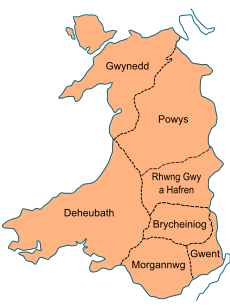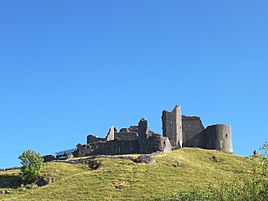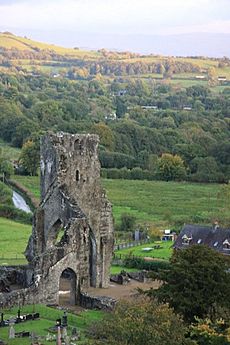Rhys ap Gruffydd facts for kids
Quick facts for kids Rhys ap Gruffydd |
|
|---|---|
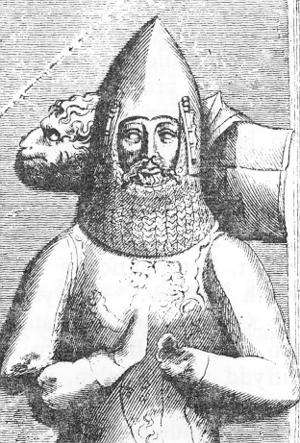
14th-century effigy of Rhys ap Gruffydd at St Davids Cathedral
|
|
| Prince of Wales | |
| Reign | 1171-1197 |
| Predecessor | Owain Gwynedd |
| Successor | Llywelyn the Great |
| Prince of Deheubarth | |
| Reign | 1155–1197 |
| Predecessor | Maredudd ap Gruffydd |
| Successor | Gruffydd ap Rhys II |
| Born | c. 1132 Caeo, Cantref Mawr, Deheubarth |
| Died | 28 April 1197 (age c. 65) |
| Burial | St Davids Cathedral, Pembrokeshire, Wales |
| Spouse | Gwenllian ferch Madog |
| Issue among others... |
|
| House | Dinefwr |
| Father | Gruffydd ap Rhys |
| Mother | Gwenllian ferch Gruffydd |
Rhys ap Gruffydd, often called The Lord Rhys (in Welsh, Yr Arglwydd Rhys), was a powerful ruler of the Welsh kingdom of Deheubarth in south Wales. He ruled from 1155 to 1197. People believed he mostly used the title "Prince of Deheubarth." However, two old papers show he also used the title "Prince of Wales" or "Prince of the Welsh."
Rhys was one of the most successful Welsh leaders during the Middle Ages. After Owain Gwynedd, the king of Gwynedd, died in 1170, Rhys became the strongest leader in all of Wales.
Rhys's grandfather, Rhys ap Tewdwr, was the king of Deheubarth. He was killed in 1093, and much of Deheubarth was taken over by the Normans. Rhys's father, Gruffydd ap Rhys, later ruled a small part of the kingdom. Rhys's older brothers won back more land after their father died. Rhys himself became the ruler of Deheubarth in 1155.
In 1163, King Henry II of England invaded Deheubarth and took all of Rhys's lands. A few weeks later, Rhys was freed and given back a small part of his land. In response, Rhys teamed up with Owain Gwynedd. Together, they stopped another invasion by King Henry in 1165, and Rhys won back his lands.
In 1171, Rhys made peace with King Henry. He was allowed to keep his lands in Deheubarth and was named the "Justiciar of South Wales." This meant he was the king's main judge and administrator in the area. Rhys stayed on good terms with King Henry until the king died in 1189. After Henry's death, Rhys fought against Richard the Lionheart. He attacked Norman areas around his territory and captured several castles.
In his later years, Rhys had trouble controlling his sons, especially Maelgwn and Gruffydd, who often fought each other. Rhys led his last military campaign against the Normans in 1196, capturing many castles. He died unexpectedly the next year and was buried in St Davids Cathedral.
Contents
Rhys's Family and Early Life
Rhys was the fourth son of Gruffydd ap Rhys, who ruled part of Deheubarth. His mother was Gwenllian ferch Gruffydd, daughter of Gruffudd ap Cynan, king of Gwynedd. Rhys had an older brother named Maredudd ap Gruffydd. He also had two older half-brothers, Anarawd and Cadell. Rhys married Gwenllian ferch Madog, daughter of Madog ap Maredudd, the last Prince of Powys.
Rhys's grandfather, Rhys ap Tewdwr, was king of all Deheubarth until he died in 1093. After his death, Norman lords took over most of his kingdom. Rhys's father, Gruffydd ap Rhys, had to flee to Ireland. He later came back and ruled a small part of Deheubarth. When Rhys was born in 1132, his father only held a small area called Caeo.
When King Henry I of England died, it led to a period of chaos called the Anarchy. This gave the Welsh a chance to fight back against the Normans. A revolt started in south Wales in 1136. Gruffydd ap Rhys, with his sons Anarawd and Cadell, defeated the Normans near Loughor. While Gruffydd was away seeking help, his wife Gwenllian led an army. She was defeated and killed by a Norman army, and her son Morgan was also killed.
Gruffydd then teamed up with Gwynedd. In 1136, their combined forces won a big victory over the Normans at the Battle of Crug Mawr. Ceredigion was taken back from the Normans, but Gwynedd kept it. Gruffydd ap Rhys died in 1137. Rhys's half-brother Anarawd became the family leader. In 1143, when Rhys was eleven, Anarawd was murdered.
First Battles and Rise to Power (1146–1155)
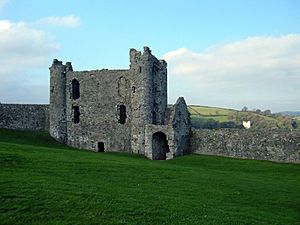
Anarawd's brother, Cadell ap Gruffydd, took over as head of the family. Rhys first appears in historical records in 1146, fighting alongside his brothers Cadell and Maredudd. They captured Llansteffan Castle. They also captured Wiston in 1147, Carmarthen in 1150, and Loughor in 1151.
In 1151, Cadell was attacked while hunting and badly injured. He survived but could no longer lead. In 1153, he went on a pilgrimage to Rome. Maredudd then became the ruler of Deheubarth. He continued the fight to get back Ceredigion, which Gwynedd had held since 1136. Maredudd and Rhys drove Hywel ab Owain Gwynedd out of Ceredigion by 1153.
In the same year, Rhys led an army on his own for the first time. He captured the Norman castle of St Clears. Maredudd and Rhys also destroyed castles at Tenby and Aberafan that year. Maredudd died in 1155 at age twenty-five, leaving Rhys as the ruler of Deheubarth.
Early Reign
Losing and Regaining Land (1155–1163)
Soon after Rhys became ruler, he heard that Owain Gwynedd planned to invade Ceredigion. Rhys built a castle at Aberdyfi in 1156 to prepare. The invasion didn't happen.
When King Stephen died in 1154, the new English king, Henry II, turned his attention to Wales. He invaded Gwynedd in 1157, forcing Owain Gwynedd to give up some land. The next year, Henry prepared to invade Deheubarth. Rhys decided to meet the king to discuss peace. The terms were very harsh: Rhys lost almost all his lands, except for Cantref Mawr.
A Norman lord named Walter de Clifford took back his lands and then invaded Rhys's territory. Rhys asked the king for help, but got no response. So, Rhys fought back, capturing Clifford's castle at Llandovery and then taking Ceredigion. King Henry prepared another invasion, and Rhys gave up without a fight. He had to give hostages, including his son Hywel.
In 1159, King Henry was in France. Rhys used this chance to attack Dyfed and besiege Carmarthen. An army led by five English earls and Owain Gwynedd's relatives marched against him. However, they had to retreat, and a truce was made. In 1162, Rhys tried again to get back his lost lands and captured Llandovery castle. The next year, Henry II returned to England and prepared another invasion of Deheubarth. Rhys met the king and had to give more hostages, including another son, Maredudd. Rhys was then taken to England as a prisoner. After a few weeks, Henry freed him and allowed him to rule Cantref Mawr.
Welsh Uprising (1164–1170)
In 1164, all the Welsh princes united in a rebellion. Rhys had good reasons to rebel. Norman lords were threatening his lands, and his nephew had been murdered. Rhys first asked the king for help, but when that failed, he invaded Ceredigion and recaptured almost all of it.
This Welsh revolt led King Henry to invade Wales again in 1165. Henry attacked Gwynedd first. He was met by the united forces of the Welsh princes, led by Owain Gwynedd and including Rhys. Heavy rain forced Henry's army to retreat without a major battle. Henry then punished the hostages, blinding Rhys's son Maredudd.
Rhys returned to Deheubarth, where he captured and burned Cardigan Castle. He also captured Cilgerran castle. In 1167, he joined Owain Gwynedd in attacking Owain Cyfeiliog of Powys. In 1168, he attacked the Normans at Builth, destroying its castle.
Rhys benefited from the Norman invasion of Ireland in 1169 and 1170. Many Norman lords from south Wales went to Ireland. Their departure allowed Rhys to become stronger. When Owain Gwynedd died in late 1170, Rhys became the recognized leader of the Welsh princes.
Later Reign
Peace with King Henry (1171–1188)
In 1171, King Henry II came to England on his way to Ireland. Henry wanted to make peace with Rhys. Rhys met him and agreed to pay a tribute of horses and cattle. In return, he was allowed to keep all the lands he had taken from Norman lords. They met again in October, and Rhys's son Hywel, who had been a hostage for many years, was returned to him. Henry then appointed Rhys as his "justice" in all Deheubarth. This meant Rhys had a lot of power and authority in Wales.
This agreement between Henry and Rhys lasted until Henry's death in 1189. When Henry's sons rebelled in 1173, Rhys sent his son Hywel Sais to help the king in Normandy. In 1174, Rhys personally led an army to help the king at a siege in England. King Henry held a meeting in Gloucester in 1175, attended by many Welsh princes led by Rhys. They agreed to help each other keep peace in Wales.
Rhys built several stone castles, including Cardigan castle, which was the first stone castle built by a Welsh ruler. He also built Carreg Cennen castle, located in a spectacular spot on a mountain.
In 1176, Rhys held a special event at his court in Cardigan over Christmas. This was a festival of poetry and song, now known as the first recorded Eisteddfod. The festival was announced a year in advance across Wales and even in England, Scotland, and Ireland. Prizes were given for the best poem and the best musical performance.
Rhys also founded two religious places: Talley Abbey, the first Premonstratensian abbey in Wales, and Llanllyr, a Cistercian nunnery. He gave a lot of money to Whitland and Strata Florida. Giraldus Cambrensis, a writer related to Rhys, wrote about meeting Rhys in 1188. Rhys was very helpful in raising men for the Third Crusade. Giraldus said Rhys wanted to go on the crusade himself but was persuaded by his wife Gwenllian to change his mind.
Final Campaigns and Death (1189–1197)
When Henry II died in 1189, his son Richard I became king. Rhys felt he was no longer bound by his agreement with Henry. He attacked Norman lordships around his territory, capturing castles like St. Clear's, Laugharne, and Llansteffan.
In his later years, Rhys struggled to control his sons, especially Maelgwn and Gruffydd. In 1189, Gruffydd convinced Rhys to imprison Maelgwn. In 1192, Rhys arranged for Maelgwn's release, but by then, Maelgwn and Gruffydd were bitter enemies. In 1194, Rhys was defeated in battle by Maelgwn and Hywel, who imprisoned him. However, Hywel later released his father.
Rhys launched his last military campaign against the Normans in 1196. He captured several castles, including Carmarthen and Radnor. He also defeated a Norman army near Radnor. This was Rhys's last battle.
Rhys died unexpectedly on April 28, 1197, and was buried in St Davids Cathedral. An old record from that time says:
... there was a great sickness throughout the island of Britain... and that storm killed countless people and many nobles and many princes, and spared no one. That year, four days before May Day, died Rhys ap Gruffydd, Prince of Deheubarth and unconquered head of all Wales.
Rhys had named his eldest legitimate son, Gruffydd ap Rhys, as his successor. Soon after Rhys's death, Gruffydd was confirmed as the heir. However, Maelgwn, Rhys's eldest but illegitimate son, refused to accept this. Maelgwn captured Gruffydd and handed him over to another Welsh prince, who then gave him to the English king. Gruffydd was imprisoned in Corfe Castle.
Rhys's Character and Legacy
Giraldus Cambrensis, a writer who knew Rhys, described him as "a man of excellent wit and quick in repartee." Gerald tells a story about a banquet where Rhys sat between two members of the Clare family, who had lost land to Rhys. The meeting was polite and even friendly, with jokes exchanged. Rhys gave Gerald a lot of help when he visited Wales to recruit soldiers for the crusade. Gerald often mentioned Rhys's "kindness."
Another writer, Walter Map, also wrote about Rhys, though he used a different name for him. Map said, "This king I have seen and know, and hate," but he also added, "I would not have my hatred blacken his worth; it is not my wish ever to suppress any man's excellence through envy." Map told a story about Rhys giving food to his enemies who were starving during a siege. Rhys wanted to defeat them by his own strength, not by hunger.
Historians say that Rhys's career was amazing. He was involved in Welsh politics for over fifty years, from his first battle at age fourteen to his death in 1197. His greatest achievement was rebuilding the kingdom of Deheubarth and making it the most important Welsh kingdom. He truly restored "the majesty of the South."
However, Rhys's achievements had two weaknesses. First, his peace agreement with King Henry was very personal and did not last after Henry's death. Second, he could not control his own sons or make them accept Gruffydd as his successor. This led to conflicts after his death.
Rhys's Children
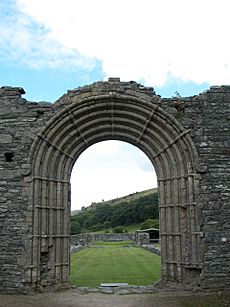
Rhys had at least nine sons and eight daughters.
- Gruffydd ap Rhys II (died 1201) was the eldest legitimate son and was chosen by Rhys to be his successor.
- Maelgwn ap Rhys (died 1231) was the eldest son, but he was illegitimate.
- Rhys Gryg (died 1233) married a daughter of the Earl of Clare.
- Hywel ap Rhys (died 1231)
- Maredudd ap Rhys (died 1239)
- Another Maredudd (died 1227) became a church official.
- Rhys's daughter Nest or Annest ferch Rhys married Rhodri ab Owain, a prince of Gwynedd.
- Gwenllian (circa 1178 – 1236) married Ednyfed Fychan, a chief officer for Llywelyn the Great. Through her, Rhys became an ancestor of the Tudor dynasty. When Henry Tudor landed in Wales in 1485 to claim the throne, his connection to Rhys helped him get Welsh support.
- Angharad ferch Rhys married William FitzMartin, a Norman lord.
See also
 In Spanish: Rhys ap Gruffydd para niños
In Spanish: Rhys ap Gruffydd para niños


